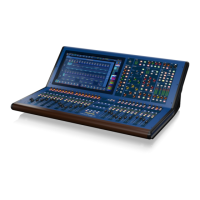65 HD96-24-CC-TP User Manual
Chapter 7. Patching
This chapter describes the patching feature of the system.
Introduction
Patching is a GUI-only feature that lets you carry out all system routing requirements.
This includes:
• • Patching audio from the on-board I/O and external I/O units into the console (Inputs, Direct Inputs, Insert Returns).
• • Patching audio from the console via the on-board I/O and external I/O units (Outputs, Bus Outputs, Direct Outputs and Insert Sends).
• • Purely internal routing, such as compressor sidechains, external gate triggers and routing to internal eects rack units etc.
• • System path setup such as talkback, shout outputs, monitoring routing, solo bus inputs, external monitor inputs etc.
The GUI top bar menu has a Patching icon that takes you to the patching screen. This contains all of the available patching connectors in the system. This screen
provides an easy-to-use interface, where you can select your source and destination patching options, facilitated by a panel of function buttons. Additionally, the
Patching screen lets you set up the I/O units (devices). For example, you can globally adjust the analogue gain or select +48V phantom voltage for all 24 microphones
at once on a DL231 mic box.
Terms used in patching:
The following is an explanation of the patching terms
Destination: The patch connector to which a signal is routed.
Patching: The process of routing a channel/signal from a source to destinations.
I/O Box: An external input and/or output hardware box such as a DL231 or DL151 to increase the systems physical connections. There are 4 AES50 ports on the console
rear for I/O expansion plus 16 more AES50 available via the 2 HMAC ports.
Device: A block in the I/O tabs that represents a physical rack unit, such as a mic splitter (DL231 etc) or Generic AES50 port.
Tab: A ‘sheet’ in the local, remote or internal page that contains a specic group of patch connectors.
Patch connector: Any patching point where audio can either be sent from or sent to, for example, an XLR connector, Output Bus, sidechain compressor etc.
Dragging: A method of selecting a block of source patch connectors from one side of the patching by swiping your nger across any channels you wish to select.
Press and Hold: Long pressing any connector on a remote or local device will select all connectors within the current page.
Local: External I/O connected directly to the surface.
Remote: External I/O connected via HyperMAC (using an DN9680) to either of the snake connections on the console rear.
Internal: Access to all the internal patching within the system (Inputs, Busses or Direct Outs etc).

